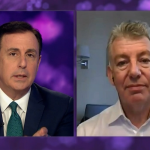Saxo Group sees the potential for higher commodity prices in 2021

Commodity prices have generally seen a strong October so far with the Bloomberg Commodity Index trading higher by 4%, thereby outperforming stocks with the S&P 500 up by around 1%. The two main sectors driving these gains has been grains, on a combination of weather concerns and strong demand and industrial metals, such as copper which reached a two-year high as the Chinese yuan surged higher and supply disruptions occurred in Chile. From a macroeconomic perspective, it has been a month where the countdown to the US presidential election has increasingly been pointing toward a win for Joe Biden.
In response to this, the market has adopted a more reflationary approach with long-end bond yields rising while the dollar has softened. Both of these developments providing some additional tailwind to commodities in general, despite a renewed surge in coronavirus cases threatening the fragile economic recovery and with that the short-term demand outlook.
Ole S. Hansen, Head of Commodity Strategy, Saxo Group, sees the potential for higher commodity prices in 2021, no matter who win the keys to the White House. Supply constraints of key commodities from metals and energy to key crops together with macroeconomic tailwinds from a weaker dollar and reflation are likely to drive commercial and speculative buying of the sector.
On that basis, Saxo maintains a bullish outlook for crude oil, copper and key crops. The same outlook for precious metals with silver potentially receiving an additional boost through its use in industrial applications. Not least solar panels where strong and potentially accelerated growth rates can be expected over the coming years as the green electrification agenda gathers pace.
The collapse in the price of and demand for crude oil during the pandemic combined with capital markets increasingly refusing to fund shale drilling – as they lose interest in the old economy, has and will drive a sharp drop in capex which will impact non-OPEC production decline rates. On that basis, we see oil and fuel prices recovering in 2021 as a rapid rebalancing of the market and higher prices may not result in rising non-OPEC production as seen during previous cycles.
The key moment in terms of a rally in crude oil will be the availability of a vaccine which should drive a recovery in global travel and commuting activities. Staying with energy, it is widely expected that a Biden win would see the US join global efforts to reduce emissions through investments in greener energy solutions while at the same time curbing the rise in shale oil production through increased regulations.
These developments should see crude oil prices, through lower supply growth, supported more by a Biden win than what would otherwise be seen with Trump staying in the White House.
In the short-term, however, crude oil and fuel products remain troubled by too much supply at a time when global coronavirus cases are surging again, thereby raising concerns about the direction of global fuel demand.
The OPEC+ group will meet on December 1 and decide whether to implement or postpone the previously agreed 1.9 million barrels/day production increase from January. With a vaccine still months away from being rolled out globally, the current slow recovery in fuel demand together with rising production from Libya has left the group with a tough decision to make.
The US election result, OPEC+ meeting and Covid-19’s impact on demand are likely to be the main factors determining where Brent crude oil will finish the year within the $38/b to $48/b range Saxo recently mentioned. For now, both Brent and WTI crude oil remain stuck in ranges in the low 40’s.
Gold has settled into wait-and-see mode while trading close to $1900/oz. It’s current struggle to find fresh momentum saw funds in the week to October 13 reduce their futures and options net-long to 12 million ounces, the lowest since June 2019 which was just before gold began its 50% rally to the current level.
Longer-term investors, meanwhile, who predominantly express their bullish views through exchange-traded products, have reduced total holdings by a mere 330,000 ounces during the past week. Apart from the fact the market has gone stale, the small reduction may reflect an emerging hesitancy ahead of the US election. With a Biden win increasingly being priced in, some may have decided to step aside until after November 3. Not least considering the memory of 2016 when the Trump win helped trigger a 15% correction in the weeks following the election.
However, the overall bullish narrative has not changed. Fiscal and monetary support will continue to increase with the second coronavirus wave hurting the already fragile economic recovery. Bond yields are rising with investors hedging against a Biden win, while challenging in the short-term, it also highlights the inflationary focus which, combined with a weaker dollar, should send precious metal prices higher into 2021.
The Bloomberg Grains Index reached a 15-month high this week and has now rallied more than 25% from the August low. While the wheat market paused following its recent surge, the rally in corn and soybeans extended further on concerns about global production at a time of strong demand. Dryness blamed on La Nina is fuelling South American production concerns at a time when China has undertaken a massive restocking programme. Potential South American and Black Sea rainfalls hold the short-term key with a very extended hedge fund long posing a correction risk. In the week to October 13, the combined net-long across six soy, corn and wheat contracts reached 627,000 lots, the highest since April 2014.
HG Copper: Following a short-lived correction in early October, HG copper resumed its ascent to reach the highest level in more than two years at $3.22/lb. It was a sharp drop in stocks held at exchange-monitored warehouses that drove the September rally. The latest leg higher, meanwhile, has occurred at a time when stock levels have started to recover. Instead, the latest extension was driven by a rally in the Chinese Yuan to the highest level against the dollar since July 2018, the risk of strike-related supply disruptions in Chile and not least the latest stimulus talks in Washington.
With all three drivers potentially only having a short-term positive impact on the market, the longer-term direction is more likely to be dictated by the following:
- China’s next five-year plan which the CCP meet next week to agree on
- The timing of a Covid-19 vaccine which may fuel a Western demand recovery
- A potential deficit next year as the green electrification agenda gathers momentum
- Macroeconomic tailwind from a weaker dollar and rising demand for reflation hedges.






